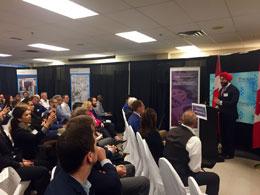When it comes to tech, US pain is Canada’s gain

Thousands of Indians techies, feeling the heat of US President Donald Trump's protectionist policies, are looking to Canada for jobs in the IT sector.
According to data provided to Hindustan Times by Immigration, Refugees and Citizenship Canada (IRCC), the agency that issues work permits to foreigners, Canada approved 4,400 applications until December 31 under the Global Skill Strategy programme it launched on 12 June 2017. The initiative is aimed at attracting top professional and managerial talent from overseas.
Of that number, over a third were Indian nationals, mainly employed in the information technology (IT) sector, making it the single largest source country of foreign employees, nearly four times the second-largest --China.
“In the global race to attract the investment of innovative companies, competitors in the European Union, as well as the United States, have considerably larger pools of talent and labour to draw from than we do in Canada,” said Lindsay Wemp, a spokesperson for the department said.
“What we’re seeing here is the movement of people who just didn’t feel comfortable because of the anti-immigrant sentiments in the United States,” Ravi Jain, a leading immigration lawyer in Toronto, said.
Jain, who practices immigration law with the firm Green and Spiegel, also said an additional attraction that Canada over the US was that many families require two incomes and in most cases, there were limitations in America on spouses working if their partners were employed on H1-Bs.
The path to permanent residency in Canada is clearly defined, and with a points system, it can be a smooth process. “It’s certainly very competitive, relative to the US,” Jain said
Shafin Diamond Tejani, the CEO of the Vancouver=based Fantasy 360 said, “This provides a great opportunity for the best talent from India to come, live and work in Canada.”
The IT workforce in India, world's largest outsourcing hub for the software industry, chiefly relies on the H1B visa program, meant for workers with specialized skill sets, to reach the US. But this has now come under close scrutiny of the Trump administration as a lion's share of H1B visas issued by the US — up to 70 percent — go to Indian nationals.
The process through which individuals acquire H1B visa has been significantly tightened making it more cumbersome and tedious. For example, an IT industry insider told DW that nearly seven out of 10 applications are now being sent through the dreaded request for evidence (RFEs), while in the past nearly 90 percent of the applications were approved straight away.
Though the RFE does not necessarily lead to a rejection in many cases, what it does is to extend the timeframe, create more opportunities for denials and delay the entry to the US.
IT services and its related business models employ about 10 million workers in India and make one of the country's booming industries since the turn of the century. More than 50 percent of IT exports from India are to the US, making it heavily reliant on Washington for its operations.
Despite the situation and a threat issued by Trump over a looming trade war, the Indian government has repeatedly underscored the importance of Indian talent in American firms and highlighted their contributions toward the US' economy.
Meanwhile, news reports in the US said an ad campaign against tech companies hiring foreign workers rolled out across San Francisco’s public transit system last week.
The campaign was paid for by Progressives for Immigration Reform, a DC-based group designated as “anti-immigrant” by the Southern Poverty Law Center (a civil rights nonprofit) in 2010.
The ads say cheap foreign labor has made US tech workers seem “expensive, undeserving, and expendable.” They advocate for laws requiring tech companies to hire US workers instead.
Advertisements in Subway, with labels: "U.S. Tech Workers! Your companies think you are expensive, undeserving, and expendable, Congress, fix H-1B law so companies must seek and hire U.S.
Kevin Lynn, executive director at Progressives for Immigration Reform, said the campaign is about protecting US jobs. “The idea is to make immigration work for the citizens as a whole,” said Lynn, whose mother immigrated to the US from Ireland in 1952. “That’s what we’ve done for a long time, but it's not doing that now.”
The campaign cost $80,000, according to a spokesperson for the Bay Area Rapid Transit system (BART) where the ads were posted. The ads will run in stations and on trains for about one month, from March to April. Lynn declined to disclose the source of PFIR’s funding, but said it “comes from foundations that support our views on immigration.”
The campaign is part of a larger US Tech Workers campaign by the group, which, according to its website, is trying to unite US-born tech workers against the three-quarters of tech workers in Silicon Valley who were born outside the country.
“Americans now fill only 29% of the tech jobs in San Jose, the cradle of Silicon Valley. Despite the demand for science, technology, engineering, and math (STEM) workers, wages have been flat for years,” the website reads. “We believe for this generation entering the workforce, and for future generations to prosper, U.S. tech companies must seek and hire U.S. tech workers first.”
Japan said it will also open up its doors to about 200,000 IT professionals from India, and issue green cards to settle down in Japan and support the country's rapidly expanding IT infrastructure.
“Currently there are around 920,000 IT professionals in the country and there is an immediate demand for more than 200,000 IT professionals from India,” said Shigeki Maeda, Executive Vice President at Japan External Trade Organisation (JETRO), a government body.









